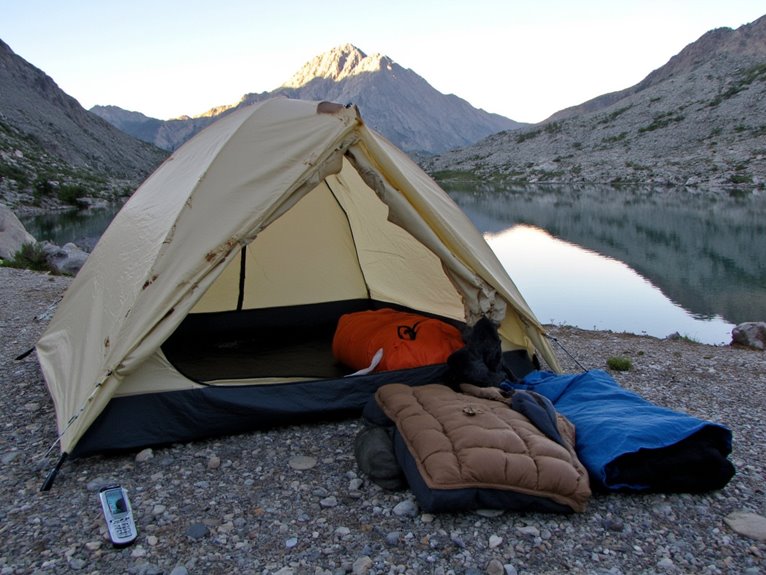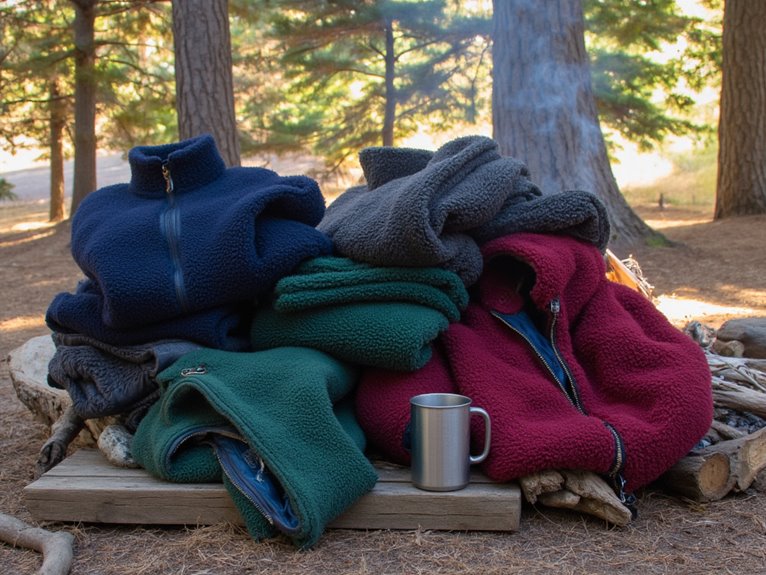Thru-Hiking Sleep Systems: Durability, Weight, and Resupply Planning
You’ll need to balance three critical factors when selecting your thru-hiking sleep system: durability, weight, and resupply strategy. Closed-cell pads offer puncture-proof reliability at 8-14 ounces, while inflatable options provide superior comfort but require careful handling. Target sleeping bags under 2 pounds with 600+ fill power down for peak warmth-to-weight ratios. Plan cache drops every 150-200 miles and carry lightweight repair kits with patches and seam sealer. Strategic planning guarantees your system performs effectively throughout your entire journey.
We are supported by our audience. When you purchase through links on our site, we may earn an affiliate commission, at no extra cost for you. Learn more. Last update on 10th December 2025 / Images from Amazon Product Advertising API.
Notable Insights
- Closed cell pads offer puncture-proof reliability at 8-14 ounces, while inflatable pads provide superior comfort but require careful handling.
- Ultralight sleeping bags under 2 pounds with 600+ fill power down provide optimal warmth-to-weight ratio for long-distance hiking.
- Cache placement every 150-200 miles allows systematic gear replacement and seasonal sleeping bag rotation for enhanced performance.
- Regular gear inspections and lightweight repair kits with patches, duct tape, and seam sealer prevent trail failures.
- Double sleeping pad systems add warmth and puncture protection while ultralight pads compress to water bottle size.
Selecting the Right Sleeping Pad Type for Long-Distance Trails
Your sleeping pad choice becomes one of the most critical gear decisions on a thru-hike, directly affecting your sleep quality and recovery for thousands of miles ahead.
Closed cell benefits include puncture-proof reliability and consistent insulation without air loss concerns. These foam pads weigh 8-14 ounces and provide backup insulation when layered beneath other pads.
Closed cell pads offer unwavering reliability with puncture-proof foam construction and dependable insulation that never fails when you need it most.
Inflatable options deliver superior comfort with 2-4 inch thickness and R-values ranging from 1.0-6.5. However, they’re vulnerable to punctures and require careful handling on rocky terrain.
Self-inflating pads combine foam cores with air chambers, offering moderate weight at 16-24 ounces. Hybrid designs merge closed-cell sections with inflatable zones for durability and comfort.
Higher-quality inflatable pads feature ripstop nylon with TPU coatings that provide greater outdoor resistance than lighter materials used in most air mattresses.
Consider your comfort needs versus weight tolerance when selecting between these fundamentally different pad technologies.
Maintaining and Repairing Your Sleep System on the Trail
After selecting your sleep system components, maintaining their performance becomes essential for completing thousands of trail miles successfully. Preventive maintenance starts with regular inspections before and during your hike.
Check sleeping bags, quilts, and pads for holes, tears, and seam integrity. Clean gear according to manufacturer specifications to preserve insulation properties. Store sleeping bags loosely during resupply breaks rather than compressed to maintain loft.
On trail repairs require a lightweight kit containing patches, duct tape, needle and thread, and seam sealer. Apply instant adhesive to small pad punctures immediately.
Use temporary stitches or safety pins for fabric tears until permanent fixes are possible. Carry patch kits designed for down or synthetic insulation. Balance repair kit weight with durability—select multifunctional materials that withstand trail conditions without adding excessive pack weight.
For sleeping pad repairs, urethane-based adhesives like Seam Grip WP provide waterproof bonding strength that’s essential for long-term trail durability.
Balancing Comfort and Pack Weight for Extended Journeys
Beyond maintaining your gear’s functionality, the fundamental challenge of thru-hiking lies in finding the ideal balance between carrying weight and getting restorative sleep night after night. Your sleep comfort directly impacts your ability to complete extended journeys, yet every ounce matters when carrying gear for months.
Ultralight sleeping bags under 2 pounds force compromises. Down fill with 600+ fill power offers superior warmth-to-weight ratios compared to synthetic alternatives. The Therm-a-Rest NeoAir Xlite exemplifies this balance at 12.5 oz with a 4.5 R-value, providing adequate insulation while maintaining reasonable pack weight.
Consider double sleeping pad systems for added warmth and puncture protection. Most quality ultralight sleeping pads compress to the water bottle size, utilizing durable 40D ripstop nylon materials that resist tears while keeping pack volume minimal.
Strategic resupply planning allows gear rotation based on seasonal conditions, optimizing both comfort and weight throughout your journey.
Strategic Gear Replacement and Cache Planning

Successful thru-hikers don’t simply carry one set of gear for thousands of miles—they orchestrate a complex logistics system that delivers the right equipment at precisely the right moments.
Your sleep system requires systematic replacement planning to maintain performance across varying conditions. Cache efficiency depends on strategic placement every 150-200 miles, coordinating with natural resupply points.
Strategic cache placement every 150-200 miles ensures your sleep system maintains peak performance when you need it most.
You’ll maximize gear longevity by rotating sleeping bags based on seasonal temperature changes and replacing sleeping pads after 800-1,000 miles of use. Mail drops provide reliable access to fresh gear without requiring personal cache retrieval.
Monitor your equipment condition weekly. Replace footwear every 500 miles and inspect sleeping bag loft monthly. Budget $200-400 for mid-hike gear replacement.
Consider ultralight sleeping pads that pack down to water bottle size for easier resupply shipment and reduced cache space requirements.
This systematic approach prevents critical failures during remote trail sections.
Maximizing Sleep Quality in Challenging Trail Conditions
Strategic gear replacement won’t matter if you can’t achieve restorative sleep when trail conditions turn hostile. Proper sleep hygiene becomes critical during adverse weather and challenging terrain.
Maintain consistent bedtime routines regardless of environmental factors. Stretching and self-massage reduce muscle tension accumulated from demanding miles. Your sleep system must create restful environments even in exposed locations.
Choose sheltered campsites protected from wind and precipitation. Layer insulated sleeping pads under sleeping bags rated 10-15°F below expected temperatures. Regulate body temperature through moisture-wicking base layers and adjustable clothing systems.
Minimize noise disruptions with foam earplugs rated for 25-30 decibel reduction. Limit bright light exposure two hours before sleep. Use eye masks or buff coverings in areas with extended daylight.
Adapt sleep schedules gradually when crossing time zones or adjusting hiking patterns for best recovery. Sleeping pads can be effectively used on snow or frozen ground, as snow’s insulation properties provide better thermal protection than rock or dirt surfaces.




